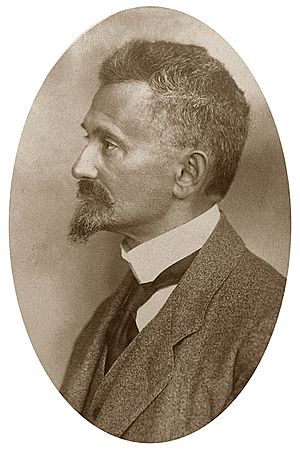Felix Hausdorff facts for kids
Quick facts for kids
Felix Hausdorff
|
|
|---|---|
 |
|
| Born | November 8, 1868 |
| Died | January 26, 1942 (aged 73) |
| Nationality | German |
| Alma mater | University of Leipzig |
| Known for |
|
| Spouse(s) | Charlotte Hausdorff (1873-1942) |
| Scientific career | |
| Fields | Mathematics |
| Institutions | University of Bonn, University of Greifswald, University of Leipzig |
| Thesis | Zur Theorie der astronomischen Strahlenbrechung (1891) |
| Doctoral advisor |
|
Felix Hausdorff (born November 8, 1868 – died January 26, 1942) was a very important German mathematician. He also wrote under the name Paul Mongré. He is known as one of the people who started modern topology. This is a branch of mathematics that studies shapes and spaces. He also made big contributions to set theory, which deals with collections of objects.
Life became very hard for Felix Hausdorff and his family, especially after 1938. He tried to move to the United States, but it was difficult to arrange.
Contents
About Felix Hausdorff
His Early Life and Education
Felix Hausdorff was born in Breslau, which is now Wrocław, Poland. His father, Louis Hausdorff, was a merchant and a very educated man. His mother, Hedwig, came from the Tietz family, who were known for starting department stores.
In 1870, Felix's family moved to Leipzig, Germany. From 1878 to 1887, he went to the Nicolai School in Leipzig. This school was known for its focus on humanities. Felix was a brilliant student. He was often the best in his class. He even wrote poems in Latin and German for school events.
When he finished high school in 1887, he decided to study natural sciences. He was the only student in his class to get the highest possible grade.
Studying at University
From 1887 to 1891, Felix Hausdorff studied mathematics and astronomy. He mostly studied in Leipzig. He also spent time studying in Freiburg and Berlin. Other students said he was very curious and interested in many things.
Besides math and astronomy, he took classes in physics, chemistry, and geography. He also studied philosophy, history, language, literature, and social sciences. He loved music and was a big fan of Richard Wagner. He even hosted music evenings at his home.
Felix worked closely with Heinrich Bruns, an astronomy professor. In 1891, Felix earned his PhD. His work was about how light bends in the atmosphere. He also completed his Habilitation (a higher academic qualification) in 1895. These early works were mathematically strong but didn't have a lasting impact on science.
Becoming a Lecturer
After his Habilitation, Hausdorff became a lecturer at the University of Leipzig. He taught many different math subjects. He also continued his interests in writing and philosophy. He met many famous writers and artists during this time.
From 1897 to 1904, he was very active in writing. He published 18 works under his pen name, Paul Mongré. These included a book of poems, a play, and a book about knowledge.
In 1899, Felix married Charlotte Goldschmidt. Her stepmother was Henriette Goldschmidt, a famous advocate for women's rights. Their only child, a daughter named Lenore, was born in 1900. Lenore lived a long life and passed away in 1991.
Moving to Other Universities
In 1901, Hausdorff became an associate professor at the University of Leipzig. There was a lot of unfair treatment towards Jewish people at the time, especially in Leipzig. This might have made him feel uncomfortable there.
Hausdorff soon focused his work on set theory. This is a part of mathematics that studies collections of objects. He started lecturing on set theory in 1901. His lectures were among the very first on this topic.
In 1910, he became a professor at the University of Bonn. He started a series of lectures on set theory there. In 1912, he began writing his most important book, Basics of Set Theory. He finished this book in Greifswald, where he became a full professor in 1913. The book was published in 1914.
The University of Greifswald was a smaller university. Hausdorff was often the only mathematician there. This meant he mostly taught basic courses. In 1921, he moved back to Bonn, which was a big step for his career. In Bonn, he could teach about more advanced topics. He gave an important lecture on probability theory in 1923. He was also friends with other great mathematicians like Otto Toeplitz.
Things Named After Felix Hausdorff
Many ideas and places in mathematics are named after Felix Hausdorff. This shows how important his work was.
Some mathematical ideas named after him include:
- Hausdorff completion
- Hausdorff dimension
- Hausdorff distance
- Hausdorff space
- Baker–Campbell–Hausdorff formula
In the cities of Bonn and Greifswald, where he taught, some places are named in his honor:
- The Hausdorff Center for Mathematics in Bonn.
- The Hausdorff Research Institute for Mathematics in Bonn.
- The Felix Hausdorff Internationale Begegnungszentrum in Greifswald.
There are also streets named after him in Bonn, Greifswald, and Leipzig. Even an Asteroid (24947 Hausdorff) is named after him!
Images for kids
See also
 In Spanish: Felix Hausdorff para niños
In Spanish: Felix Hausdorff para niños
- Gromov–Hausdorff convergence
- Hausdorff distance
- Hausdorff gap
- Maurice René Fréchet
- Hausdorff Medal


